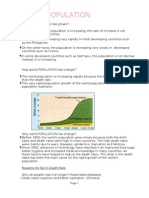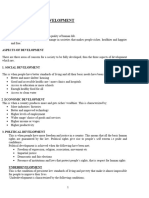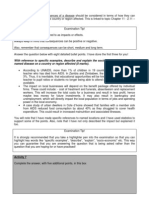Terms You Need To Know - : Population
Terms You Need To Know - : Population
Uploaded by
Unknown TrackzCopyright:
Available Formats
Terms You Need To Know - : Population
Terms You Need To Know - : Population
Uploaded by
Unknown TrackzOriginal Description:
Original Title
Copyright
Available Formats
Share this document
Did you find this document useful?
Is this content inappropriate?
Copyright:
Available Formats
Terms You Need To Know - : Population
Terms You Need To Know - : Population
Uploaded by
Unknown TrackzCopyright:
Available Formats
Population
Terms you need to know
Birth Rate:- Average number of births per thousand people.
Death Rate:- Average number of deaths per thousand people.
Rate of Natural Increase = Crude Birth Rate- Crude Death Rate
Overpopulation:-When an area’s population is too large to be supported by its
available resources.
Demographic Transition Model:- Graph suggesting sequence of change in
relationships between birth and death rates.
Population Structures:-It is the percentage of males and females in different age
groups. Depends on population’s birth and death rates and life expectancy of a
particular area. It is divided into age groups and into males and females.
Population Pyramid:- A population pyramid is a graphical representation of
population structures.
Employed:-All persons of ten years of age and above who worked one hour
during the reference period and were either “paid employed” or “self employed”.
Primary Occupations:-All such occupations that extract raw materials directly
from earth or sea eg fishing , farming , mining , forestry, animal husbandry.
Secondary Occupations:- Includes occupations which process and manufacture
the primary products eg cloth making , garment making, furniture making etc
Tertiary Occupation:- Occupations which provide services eg teaching, banking,
counseling, insurance, bus driving, politician, tourist guides, hotellers etc
Unemployment:- State of being unable to find a paid job. This situation occurs
when authorities are unable to generate enough economic opportunities for skilled
and unskilled workers. This situation creates a wide gap between demand and
supply of labour force.
Disguised Unemployment/Underemployment:- When number of workers in an
area is more than is actually needed.
Population Distribution:- It refers to the spread of people in an area. The
distribution is normally uneven and it changes as time passes.
Population Density:- Number of people living per unit area. The density of
population is obtained by dividing the total population of a country(province,
district etc) by its area.
Migration:-Movement of people from one area to another. Migration can be of
different types depending on course, duration, distance, origin, destination.
Immigrants:- People who arrive in a country from other countries. Immigrations
increase population of a country.
Emmigrants:- People who leave a country for other countries. Emmigrations
decrease population of a country.
Internal Migration:-Migration within a country eg rural to urban migration,
seasonal migration
International Migration:- Migration to other countries.
Notes
Reasons For High Population Growth:-
Economical
Child labour is common in Pakistan. Therefore large families are considered to be
advantage.
Social
Early marriages
High illiteracy rate/ People are unaware of problems caused by high birth rate
Strong desire for sons
Effective control over natural climatics eg flood , droughts, epidemics
Joint family system
Children wanted as security for old age
Religious
Deterministic outlook of Muslims. They believe that Allah gives Rizq to everyone
Family Planning programmes meet opposition on religious grounds
Political
Frequent change of governments hinders consistency of population welfare
projects
Migration of Afghan refugees in Pakistan between 1979 and 1990 due to Russian
Afghan war
Problems caused by high population growth:-
Government has insufficient money to pay for needed developments
Not enough schools
Not enough facilities for elderly….
….geriatric wards in hospitals/old age homes
….doctors/nurses
More jobs are needed by people/Unemployment
Increase in pollution
Low life expedency
Child labour may increase
Shortage of food/medicinal supplies etc leads to increased imports. Economic
progress is halted
Poverty increases. People don’t get basic facilities of life
Increasing problems in housing and settlements leads to formation of
slums/Kaccha Abadis
Wide gap between production and demand. Prices rise cause inflation and cost of
living rise steeply
Increase in crime rate
Dense traffic on roads lead to traffic problems eg traffic jams, road accidents etc
Solutions to reduce population growth and its problems:-
Initiating population welfare programs to counsel people about the problems of
population growth
Increase in literacy rate by opening schools, colleges etc
Creating more jobs eg by industrialization so that rate of economic development
outstrips rate of population growth.
Setting up of education institutions for females so that early marriages can be
avoided
Getting service of Ulemas to convince people that population growth is not
against religion
Doing telivision campaigns to increase mass awareness
Interpretation of Demographic Transition Model
Stage 1:- High birth rates and death rates. Little possible increase in population
Reasons for high birth rates
No birth control or family planning programs were in existence
Large families were taken as a matter of pride
Early marriages
Farming was the main occupation/Children needed to work on land
No use of contraceptives/Contraceptives not affordable
Use of contraceptives against religion
Desire for sons
Children wanted as security for old age
Reason for high death rates
High infant mortality rate/Children used to die of diseases like cholera,
malaria etc
Shortage of food due to traditional methods of farming
Poor hygienic facilities
Little development in medicinal science/ little use of antibiotics and life
saving drugs
Poor means of transporting doctors/medicines in needed areas
Stage II:- Birth rate remained high, death rate fell
Reason for fall in death rates
Increased medicinal facilities. Increase in number of hospitals/ increased use
of antibiotics and other life saving drugs
Improvement in sanitation and water supply
Increase in food production due to better farming methods
Decrease in infant mortality rate
Better transportation system to move doctors/food to places where they are
needed
Vaccination Programs (House to house vaccination facilities)
Balanced diet/better nutrition
Increase in doctors/nurses /medical colleges
Free treatment in government hospitals
Foreign aid
Stage III:- Birth rate fell
Reasons for fall in birth rates
Campaigns conducted by family planning programs and NGO’s like “Subz
Sitara Clinics” and “Chabi ka Nishan” etc
Increase in literacy rate
More female members of society have become career oriented/Decrease in
number of early marriages
Increase in machanisation and industrialization/Fewer manual labour needed
on farms
Improvement in living standards / More desire for material wealth than
children
Problems associated with increase in dependent age group (0-14 years) and (65 and
above) / decrease in working age group (15-64 years)
Dependency ration increases
Comparatively fewer workers to pay for /feed more young and old
Government has insufficient money to pay for needed developments
People/Industry cannot afford to pay high taxes
Not enough workers to increase social services….
…..more competition for industry /farms to get workers
…..more competion for armed services to get recruits
Not enough schools
Not enough teachers
Not enough facilities for elderly……
…..geriatric wards in hospitals/old age homes
…..relatively less doctors/nurses
More jobs will be needed as 0-14 age group moves up
Child labour may increase
Shortage of food/medicinal supplies leads to increase in imports halting
economic progress
Reasons for workforce concentration in primary occupations:-
Tradition/Inheritance
Low standard of education means secondary/tertiary occupations not open to
workers
Large percentage of population live in rural areas
Areas of Pakistan are suitable for farming
Growing population requires feeding
Pakistan has an agro based economy
Pakistan is rich in minerals e.g. limestone/salt/petroleum/natural gas
Forests are an important source of fuel
Fishing employs many in coastal fishing/some involved in inland fishing
Development of manufacturing industry started comparatively late
Low standard of living has inhibited tertiary developments
Why people employed in tertiary occupations increasing:-
Rising standards of living so greater demand for services
Increase in literacy rate
More population attracted by higher pay in tertiary services
Rural to urban migration tends to mean a change from primary to tertiary
occupation
Growth in tourism
Extension of road network
Growth in recreational activities
Fewer people making their own clothes/grow their own food therefore need
for more shops
Government efforts to improve services….
….drive to improve educational standards so more teachers/lecturers needed
….improving medicinal facilities so more doctors/nurses needed
Causes of Unemployment:-
High rate of population growth
Mechanized farming is becoming popular and fewer workers are needed on
farms
Popualrity of use of computers and information technology. Demand for
manual labour has gone down
Cultural restraints. People spend much in marriges and festivals and invest
little in economic activities eg industry, trade, farming
Mismatch in demand and supply of labour force
Many people who migrate from rural to urban areas remain unemployed
Political instability has affected investment by foreign companies and
industrial growth in Pakistan
Why illiteracy rate is higher in Pakistan?
Pakistan is a poor country/lack of money
Lack of schools/colleges in rural areas
Many only have primary education/leave school early
Schooling is not free/Parents can not afford to pay for schooling
Private schools are very expensive
Insufficient teachers/not enough teachers training colleges
Most of population are rural
Many in rural areas do not value education
Children made to work from a very young age
Girls are often not allowed to attend schools by parents
Some landlords do not allow tenants to send children to school
Many remote/isolated areas
Many (people in remote areas) are nomads/semi nomadic
Reasons why female illiteracy is higher than male illiteracy:-
Traditional attitudes (especially in rural areas)…
…..women’s place is in home
…..male dominated society
Poorer teacher to pupil ratio in girls’ school
Fewer girls given schooling
Lack of “girls only” school
Families spend limited money on boys’ education rather than girls’
Ways in which high illiteracy rate affects industrial growth:-
Illiterate workers may produce low quality goods/ donot understand
technical matters
Lack of skilled operators
Lack of skilled management
Lack of entrepreneurs
Illiterate bosses fail to plan properly
Discourages investors
May need to import expensive skilled labour halting economic progress
Illiterate workers provide cheap manual labour
Importance of training and literacy:-
Increase in literacy ratio will reduce pressure on land in rural areas
Literate labour can make economic activities more productive
Trained and skilled labour have better job opportunities in country and
abroad
Literate families are more concerned about standards of living and are
aware about advantages of small families
Increase in agricultural yield as more farmers will use modern farming
techniques
Reasons for Rural to Urban Migration
Rural Push Factors
Urban Pull Factors
Rural Push Factors
Unemployment…...
…due to mechanization
…due to insufficient farmland with increasing population
Insufficient food / famine
Drought
Water logging/salinity
Problems due to landlords/ zamindari/ feudal systems
Poor law and order situation
To escape from revenge/ lack of cultural freedom
Lack of educational facilities
Low standard of living/ poverty
Lack of health facilities
Lack of electricity/ gas
Lack of clean water
Poor sanitation
Limited shopping facilities
Limited entertainment facilities
Urban Pull Factors
Better employment opportunities
Modern amenities such as better health facilities, gas, telephone, means of
communication etc
Better education
Better job opportunities and high income
Better entertainment and recreational facilities
Better law and order situation
Cultural / religious freedom
More reliable sources of food
Consequences of Rural to Urban Migration on Urban Areas:-
Burden on civic facilities eg electricity, water, telecommunications etc
Increase in crime rate and violence
Burden on housing facilities/ Formation of slums or kaccha abadis
Increase in pollution
Traffic Problems eg increased traffic jams and road accidents
Composition of population is disturbed. As more male members come in
percentage of male members of population increase
Consequences of Rural to Urban Migration on Rural Areas:-
Composition of population is disturbed as more male members migrate to
urban areas
Reasons for Emigration from Pakistan:-
Lack of jobs in Pakistan
For higher wages/higher standard of living
Poor law and order situation
For higher education
To support family in Pakistan
Better living standards in abroad
For medical treatment
Political Reasons/ to seek more liberal way of life
Government encouragement so that foreign exchange is sent back
Positive Points of Emigration:-
Overseas Pakistanis send remittances in the form of foreign exchange
Emigration encourages flow of information technology in the country
Pressure on limited employment opportunities relieved
Overseas Pakistanis invest more capital in Pakistan than locals because of
their high income
Helps to form cultural ties between nations
Negative Points of Emigration:-
Loss of expertise
Limits tertiary services
Effects economic / scientific progress
May increase imports halting economic progress
Reasons For Seasonal Migrations Within Pakistan
To avoid scorching summers/ severe winters
In mountains take animals up to higher pastures in summer/ when snow
clears…
…bring animals down to valley pasture for winter
Move from mountain areas in winter to find jobs in plains…
….go back to farm in summers
Nomadic movements in search of pastures/ water
Work in cotton/ sugar mills after harvests then return home when work
finishes
Move from active flood plain / summer bed of river to higher ground then
back when safe
Ski instructors go to resorts in winters/ rich enjoy summer holidays in hill
stations etc.
You might also like
- BUSS1000 FrameworkDocument27 pagesBUSS1000 FrameworkTINo ratings yet
- Bridgeport Crossroads Transportation & Land Use StudyDocument95 pagesBridgeport Crossroads Transportation & Land Use StudyLancasterOnlineNo ratings yet
- This Syllabus Was Patterned From The Term 2 AY 2011-2012 Syllabus of Mr. Redencio B. Recio With Consent. Slight Modifications Were MadeDocument8 pagesThis Syllabus Was Patterned From The Term 2 AY 2011-2012 Syllabus of Mr. Redencio B. Recio With Consent. Slight Modifications Were MadeClyde CazeñasNo ratings yet
- Population Notes-Umar FahadDocument10 pagesPopulation Notes-Umar Fahadnahmednaveed123No ratings yet
- PopulationDocument36 pagesPopulationgivemore zembeNo ratings yet
- POPULATIONDocument29 pagesPOPULATIONTayyeba MaryamNo ratings yet
- Geography PresentationDocument24 pagesGeography PresentationHafsa RazaNo ratings yet
- Countries With High % of Elderly Population in 2014: JDocument10 pagesCountries With High % of Elderly Population in 2014: JOliviaNo ratings yet
- Population: Where POPULATION Has Grown?Document13 pagesPopulation: Where POPULATION Has Grown?Syasya ZdsNo ratings yet
- Screenshot 2022-11-06 at 8.57.16 AM PDFDocument6 pagesScreenshot 2022-11-06 at 8.57.16 AM PDFLeenah KawatiraNo ratings yet
- Population RevDocument13 pagesPopulation RevtshepangseitisoNo ratings yet
- Population (Umar Khan) - 2Document2 pagesPopulation (Umar Khan) - 2Mnx zNo ratings yet
- Population Growth and Economic Development: Aravinda Meera GuntupalliDocument28 pagesPopulation Growth and Economic Development: Aravinda Meera GuntupalliMarium Mahmuda ZamanNo ratings yet
- Ess Topic 8Document22 pagesEss Topic 8areenaNo ratings yet
- Human Resources and DemographyDocument16 pagesHuman Resources and Demographyvr4335349No ratings yet
- PopulationDocument65 pagesPopulationb_osborneNo ratings yet
- Compare and Contrast The Population Dynamic of HICs and LICsDocument9 pagesCompare and Contrast The Population Dynamic of HICs and LICsMegharashi Rimjhim100% (1)
- 2 Population GrowthDocument25 pages2 Population GrowthShane VeiraNo ratings yet
- Assign. 3 Development EconomicsDocument5 pagesAssign. 3 Development EconomicsSumairNo ratings yet
- MigrationDocument5 pagesMigrationm. umerNo ratings yet
- Unit 10 DemographyDocument9 pagesUnit 10 Demography202420190039No ratings yet
- Unit 2-PopulationDocument15 pagesUnit 2-PopulationMuhammad AbbasNo ratings yet
- Managing Human PopulationDocument46 pagesManaging Human PopulationAlarm ManNo ratings yet
- 4c Population StudiesDocument50 pages4c Population StudiesSabbath the sign of GodNo ratings yet
- 6.population Dynamics..EricDocument12 pages6.population Dynamics..EricDivoski D JukrNo ratings yet
- OverpopulationDocument33 pagesOverpopulationJerlyn Anne MasculinoNo ratings yet
- CAPE Environmental Science Past Papers Unit 1 & at 2005 - 2016Document3 pagesCAPE Environmental Science Past Papers Unit 1 & at 2005 - 2016sarahhannahghanyNo ratings yet
- TCW ReportingDocument4 pagesTCW ReportingMaria DubloisNo ratings yet
- Module 1Document10 pagesModule 1Jennifer ShabaNo ratings yet
- GCSE Geography-Edexcel BDocument66 pagesGCSE Geography-Edexcel BHanna HewittNo ratings yet
- Consuemr Demographics Week 4Document2 pagesConsuemr Demographics Week 4RoseNo ratings yet
- Population Pt2 - Population Growth and ChangeDocument11 pagesPopulation Pt2 - Population Growth and Changetinodashe manamikeNo ratings yet
- Development Economics Chapter 2Document1 pageDevelopment Economics Chapter 2ZohaibNo ratings yet
- S5 Ch34 PopulationDocument28 pagesS5 Ch34 PopulationEnkhjin OtgonbatNo ratings yet
- S Development Desirable FOR Every CountryDocument4 pagesS Development Desirable FOR Every CountrylemonsparklesNo ratings yet
- Population Self Made NotesDocument15 pagesPopulation Self Made Noteskhushinmaster216No ratings yet
- LDCsDocument26 pagesLDCsRahul PurmananNo ratings yet
- Demographic Transition Model V2Document11 pagesDemographic Transition Model V2Paula GómezNo ratings yet
- Growth of World PopulationDocument6 pagesGrowth of World Populationsally hakutangwiNo ratings yet
- Geography Snapshot Notes PPLDocument19 pagesGeography Snapshot Notes PPLSkye G-sNo ratings yet
- Population ExplosionDocument5 pagesPopulation ExplosionMuskan KhanNo ratings yet
- Population IssuesDocument17 pagesPopulation IssuesDennis RañonNo ratings yet
- D.V.S Notes (AutoRecovered)Document123 pagesD.V.S Notes (AutoRecovered)letlotlomazongo8No ratings yet
- Section A & B - Overall SummaryDocument9 pagesSection A & B - Overall SummaryEriane Mae C. SamaneNo ratings yet
- Major Population Issues in Developed and Developing CountriesDocument7 pagesMajor Population Issues in Developed and Developing CountriesEndugu shanti prasadNo ratings yet
- Population Dynamics 104015Document14 pagesPopulation Dynamics 104015Emily Atamelang AttyNo ratings yet
- Population Growth and Economic DevelopmentDocument15 pagesPopulation Growth and Economic DevelopmentHoney ButterNo ratings yet
- Family PlaningDocument50 pagesFamily Planingmuhamadzakir22355No ratings yet
- GLOBAL PERSPECTIVES Final RevisionDocument25 pagesGLOBAL PERSPECTIVES Final RevisionApparatus BoxNo ratings yet
- Contemporary World Week 1 ModuleDocument4 pagesContemporary World Week 1 ModuleJui ProvidoNo ratings yet
- The Pros and Cons of MigrationDocument8 pagesThe Pros and Cons of MigrationCarlos VianaNo ratings yet
- The Basic Issue: Population Growth and The Quality of LifeDocument44 pagesThe Basic Issue: Population Growth and The Quality of LifesaharsaeedNo ratings yet
- Population Explosion and ControlDocument22 pagesPopulation Explosion and Controlpratiktripathy55No ratings yet
- With Reference To Specific Examples, Describe and Explain The Socio-Economic Impact of A Named Disease On A Country or Region Affected (8 Marks)Document3 pagesWith Reference To Specific Examples, Describe and Explain The Socio-Economic Impact of A Named Disease On A Country or Region Affected (8 Marks)eibsourceNo ratings yet
- DEVELOPMENT NOTES2. EditedDocument16 pagesDEVELOPMENT NOTES2. Editedportiaseokame215No ratings yet
- Poverty The Major Cause of Underdevelopment in The Third WorldDocument11 pagesPoverty The Major Cause of Underdevelopment in The Third WorldMonisha Sweetgurl100% (1)
- Population Pt4 - Over Under and Optimum PopulationDocument7 pagesPopulation Pt4 - Over Under and Optimum Populationchiwooutlook.com.jNo ratings yet
- Research Paper On Population Growth PDFDocument8 pagesResearch Paper On Population Growth PDFfvga1ym2100% (1)
- Economic Development ReportDocument10 pagesEconomic Development ReportKiran RaniNo ratings yet
- 1.1 New POPULATION DYNAMICSDocument39 pages1.1 New POPULATION DYNAMICSSabiha SadiqNo ratings yet
- Economics Unit 5 SummaryDocument11 pagesEconomics Unit 5 SummaryABRIL SARMIENTO WENSJOENo ratings yet
- Population Case StudyDocument8 pagesPopulation Case Studyzwmkwgnys6No ratings yet
- The Sustainable Development Goals Report 2020From EverandThe Sustainable Development Goals Report 2020No ratings yet
- Assignment: ON Physical PlanningDocument8 pagesAssignment: ON Physical PlanningAhmed Milas100% (1)
- Gordon Okumu Wayumba F80-81401-2009 PDFDocument189 pagesGordon Okumu Wayumba F80-81401-2009 PDFJulius RotichNo ratings yet
- StormWater&SewerlINE Layout Sample PLAN PDFDocument1 pageStormWater&SewerlINE Layout Sample PLAN PDFRedhair ShanksNo ratings yet
- The Importance of Dealth and Life FinalDocument25 pagesThe Importance of Dealth and Life Finaloanama232No ratings yet
- MCQ - Module - 3Document5 pagesMCQ - Module - 3Rakesh Vijay Kumar100% (1)
- Answer Key Afternoon SlotDocument37 pagesAnswer Key Afternoon SlotSamiksha vcNo ratings yet
- Review of Solid Waste Management For Smart Cities in IndiaDocument5 pagesReview of Solid Waste Management For Smart Cities in IndiaGJESRNo ratings yet
- Legal Research PaperDocument55 pagesLegal Research PaperJuan Carlo Castaneda100% (1)
- PD City of Rockingham Centre Plan Final-Report Volume1 (Part2)Document54 pagesPD City of Rockingham Centre Plan Final-Report Volume1 (Part2)Purnama Sakhrial PradiniNo ratings yet
- Community, Engagement, Solidarity and CitizenshipDocument14 pagesCommunity, Engagement, Solidarity and CitizenshipCyrrha Fe QuesabaNo ratings yet
- From Satellite Townships To Smart Townships: Evolution of Township Development in Pune, IndiaDocument21 pagesFrom Satellite Townships To Smart Townships: Evolution of Township Development in Pune, IndiaAPP SPPNo ratings yet
- Pattern Desing Urban LivabilityDocument23 pagesPattern Desing Urban LivabilityEni HeldayaniNo ratings yet
- Housing Design Brief - SemVDocument9 pagesHousing Design Brief - SemVSailakshmi gNo ratings yet
- Forms of HSDocument18 pagesForms of HSSuruthi ATKNo ratings yet
- Application of Off-Site Construction For Affordable Housing in IndiaDocument95 pagesApplication of Off-Site Construction For Affordable Housing in Indiaanon_822228337No ratings yet
- Resilient Cities & Groundwater: Strategic Overview SeriesDocument6 pagesResilient Cities & Groundwater: Strategic Overview SeriesROBERTO QUIJANONo ratings yet
- Disaster ManagementDocument373 pagesDisaster ManagementPraveen KumarNo ratings yet
- Lecture1 Regional PlanningDocument16 pagesLecture1 Regional PlanningArdiansyahNo ratings yet
- PAUL Knox - Geografia UrbanaDocument26 pagesPAUL Knox - Geografia UrbanaCláudio SmalleyNo ratings yet
- Worksheet and QuestionsDocument8 pagesWorksheet and QuestionsBarry Van SelmNo ratings yet
- DILG Reports Ecological ProfilingDocument124 pagesDILG Reports Ecological Profilingjoneil0410No ratings yet
- Lesson 3-Geelect App and AssDocument2 pagesLesson 3-Geelect App and AssDensio0% (1)
- Competition BriefDocument24 pagesCompetition BriefRijaluddin HasanahNo ratings yet
- The Democratization of Food: Tin Cans and The Growth of The American Food Processing Industry, 1810-1940Document448 pagesThe Democratization of Food: Tin Cans and The Growth of The American Food Processing Industry, 1810-1940Nurazizah Melani DewiNo ratings yet
- Global Hotel IndustryDocument11 pagesGlobal Hotel IndustryJulieNo ratings yet
- Literature Review GroupsDocument2 pagesLiterature Review GroupsRakesh PatelNo ratings yet
- Urban Flood Management: Carlos E. M. TucciDocument303 pagesUrban Flood Management: Carlos E. M. TucciAnubhav KumbhreNo ratings yet

























































































